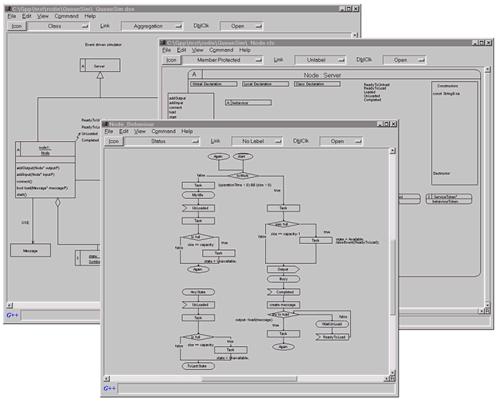SYCO G++ Software Development Environment |
 |
|||||||
Analysis, Design, Prototyping and Implementation An Object Oriented Software Environment for the Development of Concurrent Distributed Applications |
|||||||
|
|||||||
Introduction |
|||||||
The Application DomainG++ is dedicated to distributed discrete event dynamic systems, such as Automation, Telecommunications, Telephone Systems, Interactive Enterprise Management. The Class LibrariesSupporting both the C++ and Java programming languages. The environment contains over 300 basic classes divided into several libraries covering: basic types and data structures; classes for concurrency, discrete event simulated and real-time systems; graphical objects, editors and GUI based on OSF-Motif or MS-Windows; distribution; persistency; Business Logic and Business Objects. Common functionality of the library All objects of the library enjoy (for C++, optional run-time pointer
checking) exceptions and errors handling, function tracing, persistency
and the «callback» mechanism for event based programming.
The G++ Active Object Pattern The design is conceptually supported by a pattern language where control
applications are modelled as a set of concurrent/distribut-ed servers
that render services (i.e. sequences of operations developed over time)
to their clients. The class Server is the G++ abstract definition of the
«active» object of the framework. The service implementation can be delegated to the fine grain, event driven, interaction of sequential objects in the service scope. |
Business Application FrameworkBAF, enabled by J2EE™ technology, has been conceived for global scale applications, with:
Software Development Process The software development process is driven by a pattern language which
enables an evolutionary approach based on transformations: from the analysis,
to the logical design and prototyping then to the physical design and
implementation on a distributed computer platform. Analysis - high level designAnalysis and high level logical and physical design are carried on using the UML object model. Class design - Interface definition A detailed class design editor adopts the ESA-HOOD modelling technique,
and extends it to the C++ and Java languages. The behaviour editorAn OO extension of SDL (the Specification and Description Language of the CCITT) is used for the specification and prototyping of the dynamic behaviour of objects for both fine and medium grain levels of concurrency. The environment supports the automatic generation of the code for the object control logic both for event based, and process based programming. Interaction tree diagrams At the highest interaction level an innovative graphical tool supports
BAF for modelling web-centric interaction sessions.
It generates automatically Java classes and JSP fragments. |
||||||
More Documents |
|||||||
You can get more information about SYCO G++ from the following sources: |
|||||||